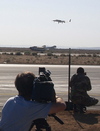The thing about the da Vinci Project is … people are skeptical it will work. Just after my story was published Thursday about how the volunteer X Prize team had found an angel sponsor and will do its balloon-and-rocket-to-space launch in October, I got an email from a reader: “$20 bucks says the guy torches on re-entry, … assuming the airborne launch even works.”
Is that just a Nascar crash fantasy at work? Or a well-informed doubt?
People following the X Prize have seen Burt Rutan’s SpaceShipOne craft fly, know that it has a deliberate testing history, and that it comes from a team guided by a very smart, capable guy and funded by a very rich one (Microsoft billionaire Paul Allen). When it comes to da Vinci and its Wild Fire spacecraft, there’s none of that history and consequently none of the confidence that at least it’s not a crazy stunt.
Last week, Rutan asked Brian Feeney at the X Prize press conference in Santa Monica whether da Vinci would do any “envelope expansion” flights before launching for space. In other words, would there be a program of deliberate testing before committing to a full-on launch? Feeney’s answer to me when I asked a similar question at the end of June was that there is no way of really doing a full system test because of the balloon-launch element. He seemed to suggest it was too complex practically to do a complete test. Thursday when I interviewed him he told me the team wouldn’t disclose details of any upcoming tests for competitive reasons.
Here was his exchange with Rutan:
Rutan: Do you mind if I ask a question? Or do I have to go down there [with the media attending the conference]? Are you going to fly a spaceflight on your first flight, or are you going to do envelope expansion?
Feeney: Yeah, Burt, actually you asked me that question about two months ago here when were out to dinner. The X Prize got together a group of twelve competitors a couple of months ago and we talked about all our various efforts. But the second night we were at the Cafe Del Rey and I happened to be sitting opposite Burt, and over fine wine and dinner for about four hours we kept bantering back and forth about rockets, and I think we asked each other 12 different ways and gave each other 12 different answers about when and how we were gonna fly. Um, now we, uh, it’s generally our intent to go to space on our first flight. We have a ballistic rocket. It’s not a — I’ll call SpaceShipOne a space plane — it does not have wings. We’re launching at such a high altitude, 80,000 feet, that we’re well on our way. We do not have — it’s a a standing start, so things like wind shear that are, maybe have complicated the past SpaceShipOne flights, are not a factor for us. We’ve got 1.2 million pound seconds of total impulse on board, which doesn’t mean much to most of you but it’s one hell of a lot of energy, and that’s going to take us out there. So yeah, we’ll … we’ll … short of something else that occurs in the meantime, we’ll go for it.
To be fair, Rutan asked a simple enough question, and Feeney answered it. But the question was loaded, too: Are you doing testing to prove what your ship can do? And if not, why not? The assumption underlying the spoken and unspoken question is one all of us who grew up in the space age are familiar with: If you’re going to do something crazy like light off some explosives and shoot yourself into space, it makes sense to be very, very sure you know what you’re doing. Go a step at a time. Expand the envelope. Push to discover unexpected problems and resolve them. Especially if you’re going to put someone’s life on the line.
In his reply, Feeney addressed the loaded part of Rutan’s query. But look at what he said. Is there really a straight answer there? The first Wild Fire shot will be to space. Because the ship will be launching from so high up. Because it has such a powerful rocket motor. Because Wild Fire should be easier to fly than SpaceShipOne. Those are all factors that Feeney is counting on to get him to space, and computer modeling probably shows him that it’s all going to work out fine. But none of that adds up to a reason for foregoing a full test of how all the pieces of the da Vinci Project’s system work when they’re integrated and used under the stress of real-world conditions.
Outsiders can only guess why Feeney has chosen not to do more extensive testing and to report it publicly. It probably comes down to a simple matter of not enough money on one hand and not enough time to test and still have a shot at the X Prize.
That sense that something is going off half-cocked is what leads to the feeling expressed by the Wired News reader that Feeney’s headed for a disaster. I’m not going to take that bet. I’d hate to see that happen, even if promoters of the new space race (and the experience of the old one) show that disasters are just part of reaching for the stars.



